How not to recognize that the mules - the strongest, sober and endowed with an extraordinary sense of balance between the equine - have been in the past century an irreplaceable system of mobility even for the Armed Forces, especially if we think of those high mountain trails , narrow and tiring, that our soldiers had to cross carrying supplies and heavy artillery pieces.
Already starting from 1950, the technology has proposed two motorized systems that should have replaced the work of the mules and consequently lighten the physical fatigue of our soldiers.
Probably sorry to observe an animal forced to sustain efforts when one would prefer to see it free to graze, however for mules and more generally for horses, work has always been a prerogative linked to their physical characteristics, clearly much appreciated by man. , which in turn favored its evolution and reproduction.
In the Army there has always been great respect and feeling between men and horses in general, a bit like in other sectors, for example between police officers and anti-drug or anti-explosive dogs. Moreover, in the glorious pages that the body of the Alpini wrote on the war front almost always the mule was described as a valid and irreplaceable collaborator who faithfully placed our soldiers in the mountain marches towards the trenches.
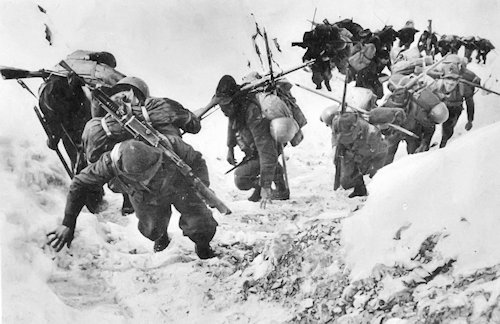 They were framed as actuals in battalions or batteries, just like soldiers, and their leaders became attached to the animals entrusted to them as happened with the horses in the artillery case. The affection was always matched by the animals who reciprocated the care received with devotion.
They were framed as actuals in battalions or batteries, just like soldiers, and their leaders became attached to the animals entrusted to them as happened with the horses in the artillery case. The affection was always matched by the animals who reciprocated the care received with devotion.
The initial idea was a crawler motorbike
In the middle of the last century Colonel Ferruccio Garbari took care of the motorized technologies of our Army and was in contact with the greatest Italian automobile engineers, among them the engineer Busso, who was the precursor of the legendary Alfa Matta, and probably also with the Moto Guzzi designers. Meanwhile, within the OARE workshops (Officina Automobilistica Riparazioni Esercito) today called CERIMANT, Colonel Garbari, promoted shortly after brigadier general, addressed the issue by proposing the project of a vehicle capable of gradually replacing the mules under the Army. .
Probably there was not a real need to make a replacement of a "proven system" but probably the technological evolution and the economic possibilities of that time, allowed to persevere on this idea.
This project took the name of "mechanical mule", perhaps "in honor of equine merit".
Moto Guzzi started the production of the 3x3 prototype, but what was it essentially about?
To immediately give an idea of the type of vehicle that was being born as a prototype within military establishments, I could refer to some films from the Second World War, or to the nicer Sturmtruppen comics, where often on board motorized and tracked tricycles, German Wehrmacht soldiers were depicted.
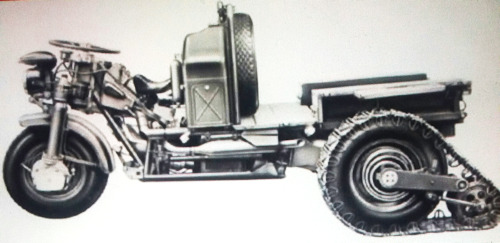
It was a motor vehicle used for the transport of five soldiers (including the driver) with two removable rear tracks and with a great novelty: the single front wheel had the traction that can be inserted and to turn there was not a handlebar but a normal steering wheel. Essentially a 3X3 which, due to its technical complexity and conical couplings and mechanical cardan joints, required careful maintenance, but at the same time offered a hill older anti-rollback system - mechanical of course - and a five-speed gearbox plus reduced speed. insertable, and the lever was the yoke type as for cars.
Even its rear (track width) width could be reduced to tackle the narrower passages.
It was assembled using spare parts and unused material in stock and its tracks came from segmented links of small tanks like the M13 / 4.
Mechanics, on the other hand, were the flagship of Italian motorcycle production, in fact it was equipped with the V7, or a 703 cc 90 ° twin-cylinder adopted for the legendary Moto Guzzi Falcone supplied to the Italian army.
A good idea, but had no future despite some prototype had participated in a parade of the 2 June of that period; the mules therefore continued to remain the best indefatigable aid for the Alpine troops, at least until the end of the 80 years.
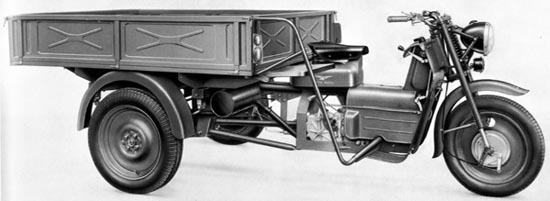 Perhaps it was the ease with which it could be overturned with its only three wheels, or its weight of five quintals or the need for constant maintenance to declare the abandonment of this vehicle from the military scene.
Perhaps it was the ease with which it could be overturned with its only three wheels, or its weight of five quintals or the need for constant maintenance to declare the abandonment of this vehicle from the military scene.
With some modifications, the project resumed life between the sixties and seventies with two civil vehicles that Moto Guzzi baptized Hercules ed Ercolino (image); highly appreciated motorized tricycles, on construction sites but also by traders as an alternative to vans. When I was a child, a carpenter parked one in front of my house.
Also in the last century another vehicle arrives ... the controversial MTC 80 motorcycle racer!
After the unsatisfactory debut of the tracked tricycle, the idea of General Garbari to facilitate the mobility of the Alpine troops was not abandoned at all. A military commission entrusted the task to the company Fresia SpA which, for civil and construction purposes, already produced a sort of quad, a trolley with four wheels and a motorized platform.
The Fresia company is still today a solid national reality based in Liguria and exactly in Savona where, back in 1923, the entrepreneur Giovanbattista Fresia decided to specialize in the mass production of small tractors, some of which with hydrostatic drive.
Today's production of Fresia is particularly linked to the construction and fitting out of vehicles used for public utility such as some versions for firefighters and civil protection, but also heavy snowploughs for highway cleaning. His name is now synonymous with international quality and efficiency and his mission company guarantees a lot of stable work to the workers.
The vehicle commissioned by the Defense had an unusual set-up, and let's face it immediately, it appeared unreliable; after all I imagine that some readers already know of the lack of practical success of the MTC80 encountered shortly after its entry into the barracks.
In fact, he did not offer any particular help on the most insidious mule tracks, but he managed not to lose his balance, even if very loaded, only on the major false plateaus or on the steep grasslands strewn with stones.
But let's now deal with the technology of this four-wheeler. The MTC consisted of a platform with the addition of a steering wheel and its driving could take place either from the ground while walking, rather than from sitting sportily on the edge of the platform itself. Its width was just over a meter, a measure greater than what a mule would occupy on a mountain path; the length, on the other hand, was around two meters.
Almost a small parallelepiped, but with big limits. Moved by an engine Briggs & Stratton initially a single cylinder with a pull start and then two cylinders from 700 cc supplied a power of only 18 horses, which favored, as you can imagine the torque, maintaining the speed below the 20 km / h. The engine was placed between the two axles in a space of one and twenty meters, this above all to optimize the dimensions and the spaces and at the same time guarantee a certain stability of the center of gravity.
Il quad as an example
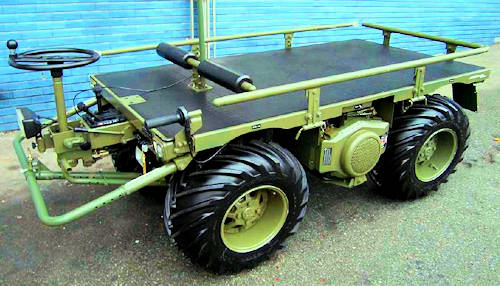
It is no coincidence that I first wanted to take the example quad, the four-wheel-drive short quadricycle that, despite having a different subdivision of the masses, may behave similarly in certain extreme uses ofoff road, as for example, anterior impaction.
The 430 kg of payload of the MTC80 did not give it great stability and it was not at all difficult for the motorcar to tip over sideways; perhaps it was almost more stable frontally when it exceeded slopes of over 50 degrees. The two axles were steered and its tires, albeit with a small diameter, were very large and similar in the tread design to those of a common off-road vehicle; a strong point then the grip on the ground of the tires, at least to compensate for the forces exerted by the loads that could put in crisis the center of gravity in the maneuvers.
The engine was actually a hydraulic pump that put the oil under pressure, as is the case with construction machinery, and the pressure generated reached small turbines placed in its two differentials, one front and the other rear.
The mass of a hundred quintals added to the flow rose to almost a ton the weight of the MTX 80, which at this point could equal that of a small car; an aspect, little operational probably, that disappointed the expectations of our military.
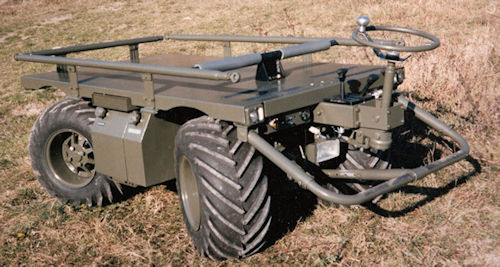
Fresia F18
This was the most modern name of the MTX 80 and perhaps many do not know that even the American Marines used it but with different and probably better results, considering the Middle East lands best suited to its characteristics.
We must also say that after a few hundred purchases, many MTC and F18 were parked in the barracks and no longer used, but only started and moved occasionally to keep them efficient and operational.
A robot is being studied in which the US Army would seem interested and which could represent the forerunner, in the coming decades, of a revolutionary concept of the Army.
Maybe talking about robots is a bit sci-fi today, but the internet was too 40 years ago, as well as drones, and although my wish is with the conviction that man no longer needs to harm himself, let's look together at what it is, admired as well as by the technique, by its similarity with the mules, gloriously released from the scene of the Armed Forces in '90.
LS3
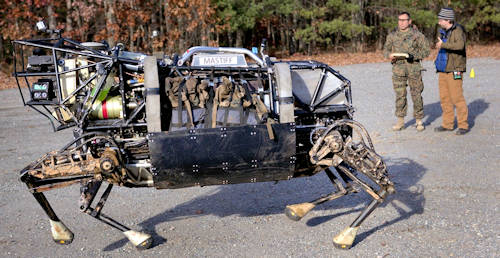
The robot is a creation of Boston Dynamics and its technical name is LS3 (Legend Squad Support System). In this case it is a sort of horse able to travel distances of over 180 kilometers with a 30kg load and its power supply is both solar and lithium batteries.
These have been tested specimens with a two-stroke engine used exclusively as a generator for the batteries.
Sophisticated systems keep the machine in balance even on ice sheets, while its dynamic line and low weight allow it at least the same performance of the sympathetic and intelligent even if stubborn mules.
(images: US DoD / web / Boston Dynamics)












